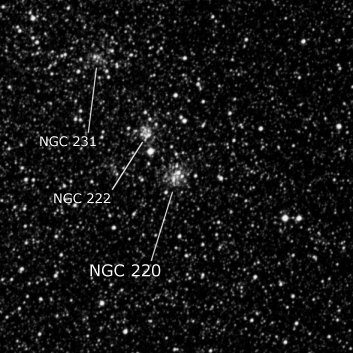
John Herschel discovered NGC 220 = h2338, along with NGC 231, on 12 Aug 1834 in the SMC and recorded "F, vgbM, irregular figure." On a second sweep he wrote "The first of an irregular string of nebulae and stars which descends at an angle of about 45 degrees from the centre to the edge of the field (i.e. in a north-following direction)." Finally, on a third sweep he recorded "F, R; the field is full of the nebulous light of the Nubecula Minor." Harold Corwin notes that NGC 222 = h2339 may be a 4th observations of this cluster (see notes).
James Dunlop probably made an earlier discovery of NGC 220 = D 2 on 1 Aug 1826 using his 9" reflector. He described a "faint nebula, about 1 1/2' long, irregular figure, rather branched. This is involved in the margin of the Nebula minor." His position is 3.6' NW of NGC 220, though given his general poor positions this identification is not certain. Herschel assigned D 2 to NGC 231 = h2340 instead.
Pietro Baracchi observed the cluster on 16 Dec 1887 (first of 14 objects) with the Melbourne telescope and called it "pB, irr, pS, lBM, amidst stars."
400/500mm - 18" (7/10/05 - Magellan Observatory, Australia): at 228x, this SMC cluster appeared moderately bright, fairly small, round, ~50" diameter, brighter nucleus. There was no resolution except for a single faint star near the center. A mag 11 star lies 1' NE and just south of NGC 222. NGC 220 is the first of three in a chain with NGC 222 1.5' NE and NGC 231 4.0' NE. Also NGC 176 lies 24' NW. NGC 220 is located at the west edge of a large SMC star cloud (Hodge Association 3).
Notes by Steve Gottlieb